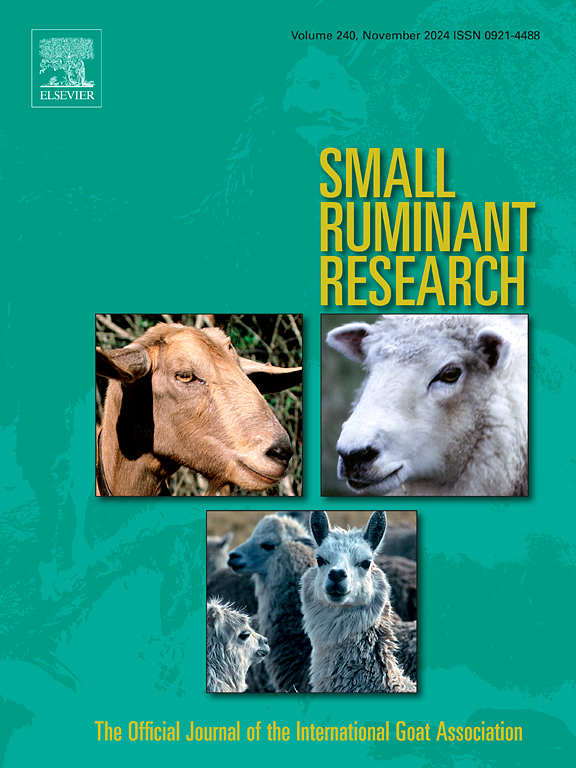Machine learning-based prediction of pre-weaning lamb survival using animal-, housing-, and management-related factors
IF 1.4
3区 农林科学
Q2 AGRICULTURE, DAIRY & ANIMAL SCIENCE
引用次数: 0
Abstract
The aim of the study is to classify lambs that will survive or die before weaning by using animal- and farm-related factors as predictors through machine learning (ML) algorithms, and to identify potential risk factors associated with lamb mortality in housed management systems. Survival records from birth to weaning of a total of 5539 lambs were analysed from ten farms, which reared Kivircik sheep. To predict whether the lambs will survive from birth to weaning, Decision Tree (DT), Random Forest (RF), K-Nearest Neighbors (KNN), Naïve Bayes (NB), Boosting, Logistic Regression (LR), Support Vector Machine (SVM) and Multilayer Perceptron (MLP) classifiers were tested. The survival of lambs in the raw dataset was 91.7 %. The highest accuracy (0.925) in classifying living or dead lambs was obtained by Boosting algorithm, while the second highest performance (accuracy of 0.897) was shown by RF. NB, LR, and SVM algorithms achieved relatively lower classification accuracies, ranging between 65 % and 67 %. According to the Boosting algorithm, birth weight was identified as the variable with the highest relative influence with 43.4 %. It was followed by birth month (12.2 %), number of ewes per shepherd (11.2 %), floor space per ewe (10.0 %), and birth rank group (7.0 %). In conclusion, Boosting algorithm demonstrated high classification accuracy in predicting lamb survival. Moreover, the strong predictive influences of birth weight, number of ewes per shepherd, floor space per ewe, and birth rank group indicate the importance of focusing on gestational nutritional management, husbandry conditions, and overall herd management practices in developing intervention strategies to reduce lamb mortality in housed management systems.
基于机器学习的断奶前羔羊存活率预测,使用动物、房屋和管理相关因素
该研究的目的是通过机器学习(ML)算法,利用动物和农场相关因素作为预测因素,对断奶前存活或死亡的羔羊进行分类,并确定与圈养管理系统中羔羊死亡率相关的潜在风险因素。研究人员分析了来自10个饲养Kivircik羊的农场的5539只羔羊从出生到断奶的存活记录。为了预测羔羊是否能从出生到断奶,测试了决策树(DT)、随机森林(RF)、k近邻(KNN)、Naïve贝叶斯(NB)、Boosting、逻辑回归(LR)、支持向量机(SVM)和多层感知器(MLP)分类器。羔羊在原始数据集中的存活率为91.7 %。boost算法对活羊和死羊的分类准确率最高(0.925),RF算法的分类准确率次之(0.897)。NB、LR和SVM算法的分类准确率相对较低,在65 %和67 %之间。根据Boosting算法,出生体重被确定为相对影响最大的变量,为43.4% %。其次是出生月份(12.2 %)、每个牧羊人的母羊数(11.2 %)、每只母羊的占地面积(10.0 %)和出生等级组(7.0 %)。综上所述,Boosting算法在预测羔羊存活率方面具有较高的分类准确率。此外,出生体重、每个牧羊人的母羊数量、每只母羊的占地面积和出生等级组的强大预测影响表明,在制定降低圈养管理系统中羔羊死亡率的干预策略时,关注妊娠期营养管理、饲养条件和整体羊群管理实践的重要性。
本文章由计算机程序翻译,如有差异,请以英文原文为准。
求助全文
约1分钟内获得全文
求助全文
来源期刊

Small Ruminant Research
农林科学-奶制品与动物科学
CiteScore
3.10
自引率
11.10%
发文量
210
审稿时长
12.5 weeks
期刊介绍:
Small Ruminant Research publishes original, basic and applied research articles, technical notes, and review articles on research relating to goats, sheep, deer, the New World camelids llama, alpaca, vicuna and guanaco, and the Old World camels.
Topics covered include nutrition, physiology, anatomy, genetics, microbiology, ethology, product technology, socio-economics, management, sustainability and environment, veterinary medicine and husbandry engineering.
 求助内容:
求助内容: 应助结果提醒方式:
应助结果提醒方式:


